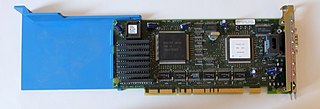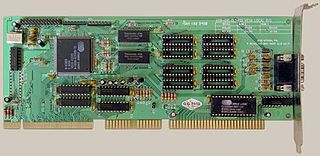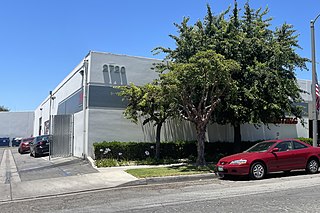Related Research Articles

Video Graphics Array (VGA) is a video display controller and accompanying de facto graphics standard, first introduced with the IBM PS/2 line of computers in 1987, which became ubiquitous in the IBM PC compatible industry within three years. The term can now refer to the computer display standard, the 15-pin D-subminiature VGA connector, or the 640 × 480 resolution characteristic of the VGA hardware.

Micro Channel architecture, or the Micro Channel bus, is a proprietary 16- or 32-bit parallel computer bus introduced by IBM in 1987 which was used on PS/2 and other computers until the mid-1990s. Its name is commonly abbreviated as "MCA", although not by IBM. In IBM products, it superseded the ISA bus and was itself subsequently superseded by the PCI bus architecture.

Super VGA (SVGA) is a broad term that covers a wide range of computer display standards that extended IBM's VGA specification.

The LTE is a line of laptops manufactured by Compaq Computer Corporation, introduced in 1989 and discontinued in 1997. It was the first notebook-sized laptop sold by Compaq and the first commercially successful notebook computer, helping launch the burgeoning industry.

Mylex Corporation was an American computer company active from 1983 to 1999. The company mainly produced peripherals and expansion cards for personal computers—chiefly the IBM Personal Computer—for the bulk of its existence, although it also produced complete motherboards. In the mid-1990s the company focused on designing and manufacturing RAID controllers, eventually cornering 75 percent of the RAID controller market. In 1999, the company was acquired by and made a subsidiary of IBM for approximately $240 million. In 2002, IBM sold their Mylex division to LSI Logic for an undisclosed amount.
A multiple-sync (multisync) monitor, also known as a multiscan or multimode monitor, is a raster-scan analog video monitor that can properly synchronise with multiple horizontal and vertical scan rates. In contrast, fixed frequency monitors can only synchronise with a specific set of scan rates. They are generally used for computer displays, but sometimes for television, and the terminology is mostly applied to CRT displays although the concept applies to other technologies.

Reply Corporation, often shortened to Reply Corp., was an American computer company based in San Jose, California. Founded in 1988 by Steve Petracca, the company licensed the Micro Channel architecture from IBM for their own computers released in 1989, competing against IBM's PS/2 line. The company later divested from offering complete systems in favor of marketing motherboard upgrades for older PS/2s. Reply enjoyed a close relationship with IBM, owing to many of its founding employees, including Petracca, having worked for IBM. The company was acquired by Radius in 1997.

American Computer & Peripheral, Inc. (AC&P), also written as American Computer and Peripheral, was an American computer company based in Santa Ana, California. The company was founded in 1985 by Alan Lau and released several expansion boards for the IBM PC as well as a few PC clones before going bankrupt in December 1989. Obscure in its own time, the company's 386 Translator was the first plug-in board for Intel's newly released 80386 processor and the first mass-market computing device to offer consumers a means of using the 386 in July 1986.

The Personal System/2 Model 30 and Personal System/2 Model 30 286 are IBM's entry-level desktop computers in their Personal System/2 (PS/2) family of personal computers. As opposed to higher-end entries in the PS/2 line which use Micro Channel bus architecture, the Model 30 features an Industry Standard Architecture bus, allowing it to use expansion cards from its direct predecessors, the PC/XT and the PC/AT. The original PS/2 Model 30 is built upon the Intel 8086 microprocessor clocked at 8 MHz; the Model 30 286 features the Intel 80286 clocked at 10 MHz.

The MacEnhancer is an expansion box originally developed in 1985 by Microsoft for Apple Computer's original Macintosh. Plugged into either the Macintosh's serial printer or modem ports, the MacEnhancer provides IBM-standard printer and serial ports as well as a passthrough for the Mac-standard serial port, for a net gain of three peripheral ports. Along with a provided disk of drivers, this expansion box allows the Macintosh to run a host of printers and other business peripherals not originally supported by Apple.

The SupersPort is a line of PC-compatible laptops manufactured by Zenith Data Systems and sold from 1988 to 1993. The first two main entries in the SupersPort line included either an Intel 80286 microprocessor clocked at 12 MHz or an 8088 processor clocked at 8 or 4.77 MHz, switchable. Later entries included the 386SX, 486SX and 486 processors. The SupersPort 286 in particular was one of the top-selling laptops of the late 1980s, although Zenith's position in this segment faltered by the early 1990s.

Cumulus Corporation was an American computer peripheral and system manufacturer active from 1987 to 1993. Based in Beachwood, Ohio and started by Tecmar founder Martin Alpert, the company set out to exclusively manufacture expansion products for IBM's Personal System/2 (PS/2) family of computers—mainly RAM expansion cards. It later released cross-platform CPU upgrade cards and memory expansion cards for other platforms besides the PS/2. Beginning in 1990, the company began trading as Cumulus Computer Corporation and began releasing complete systems of their own. Initially a success story for the tech industry in Cleveland, a botched stock launch in 1992 proved disastrous for the company's ailing cash flow situation, and in 1993 the company was liquidated amid massive debt to suppliers and lenders.

Parallax Graphics, Inc., was an American developer and manufacturer of high-specification computer graphics cards for various platforms, and of supporting software. The company was founded in 1982 as Parallax Systems by two Cornell University graduates.

Paradise Systems, Inc., was an American video controller and graphics adapter card manufacturer active from 1982 to 1996. The company became a subsidiary of Western Digital when they purchased Paradise in 1986; in 1995, they sold the division to Philips, who subsequently folded it after less than a year.

Reveal Computer Products, Inc., was a short-lived American computer peripheral manufacturer active from 1992 to 1996. It was established as a subsidiary of Packard Bell Electronics, an American computer company. The company was once a major player in the IBM PC peripheral market, with annual sales peaking above the US$200 million mark. It went bankrupt in 1996 after an aborted $65-million merger with Creative Technology.

BusLogic, Inc., was an American computer company active from 1988 to 1996. It specialized in the production of Small Computer System Interface (SCSI) device controller chips and controller expansion cards, becoming a dominant player in that market, behind only Adaptec. In 1996, the company was acquired by Mylex Corporation.

Genoa Systems Corporation, later Genoa Electronics Corporation, was an American computer multimedia peripheral vendor based in San Jose, California, and active from 1984 to 2002. The company was once a prolific and well-known manufacturer of video cards and chipsets. They also dabbled in modems, tape drives, sound cards, and other peripheral expansion cards. The company was a founding member of the Video Electronics Standards Association (VESA) and were instrumental in the development of Super VGA.
Actix Systems, Inc., was an American graphics adapter manufacturer active from 1990 to 1998 and based in the San Francisco Bay Area. The company was founded by Stephen W. Cheng and initially specialized in a subset of graphics adapters known as GUI accelerators, becoming a major player in the field. Toward the mid-1990s the company began manufacturing more general-purpose adapters under their GraphicsEngine brand.
Micronics Computers, Inc. was an American computer company active from 1986 to 1998 that manufactured complete systems, motherboards, and peripherals. Based in the San Francisco Bay Area, Micronics was one of the largest domestic motherboard manufacturers in the United States in the 1990s. After acquiring Orchid Technology in 1994, the company entered the market for multimedia products, such as graphics adapters and sound cards. In 1998, Micronics was acquired by Diamond Multimedia.
References
- ↑ Gardner, Valerie (February 1990). "Willow predicting a small revolution in computer design". Computer Pictures. Access Intelligence. 8 (2): 47 – via Gale.
- 1 2 3 Carlson, Eugene (August 12, 1993). "South Bronx Address Can Give a Firm Reverse Cachet". The Wall Street Journal. Dow Jones & Company: B2 – via ProQuest.
- ↑ High Technology Market Place Directory. Princeton Hightech Group. 1999. p. 886 – via Google Books.
- 1 2 Sherwin, Richard (June 6, 1989). "Small biz, big ambitions". New York Daily News: MP3 – via Newspapers.com.
- 1 2 Lohr, Steve (October 12, 1992). "New York a Hard Town for High-Tech". The New York Times: D1 – via ProQuest.
- 1 2 3 Ditlea, Steve (September 13, 1993). "Facing technical difficulties: Willow Peripherals beats odds in Bronx". New York Daily News: 24 – via Newspapers.com. ProQuest 390835437.
- 1 2 Webster, John (September 26, 1988). "VGA-compatible hardware makers seek ways to pull ahead of the pack". PC Week. Ziff-Davis. 5 (39): 112 – via Gale.
- 1 2 Fram, Jonathan (November 21, 1988). "Willow kids: not your normal South Bronx start-up". PC Week. Ziff-Davis. 5 (47): 77 – via Gale.
- ↑ Poor, Alfred (July 1989). "VGA and NTSC: Putting Your Program on TV". PC Magazine. Ziff-Davis. 8 (13): 158 – via Google Books.
- ↑ Grunin, Lori; Tom Giebel; John R. Quainn (September 29, 1992). "VGA-to-NTSC Boards: Let's Go to the Videotape". PC Magazine. Ziff-Davis. 11 (16): 239–293 – via Google Books.
- ↑ "Official website of Willow Peripherals". Willow Peripherals. March 27, 2004. Archived from the original on March 27, 2004. Compare with next available archived snapshot.